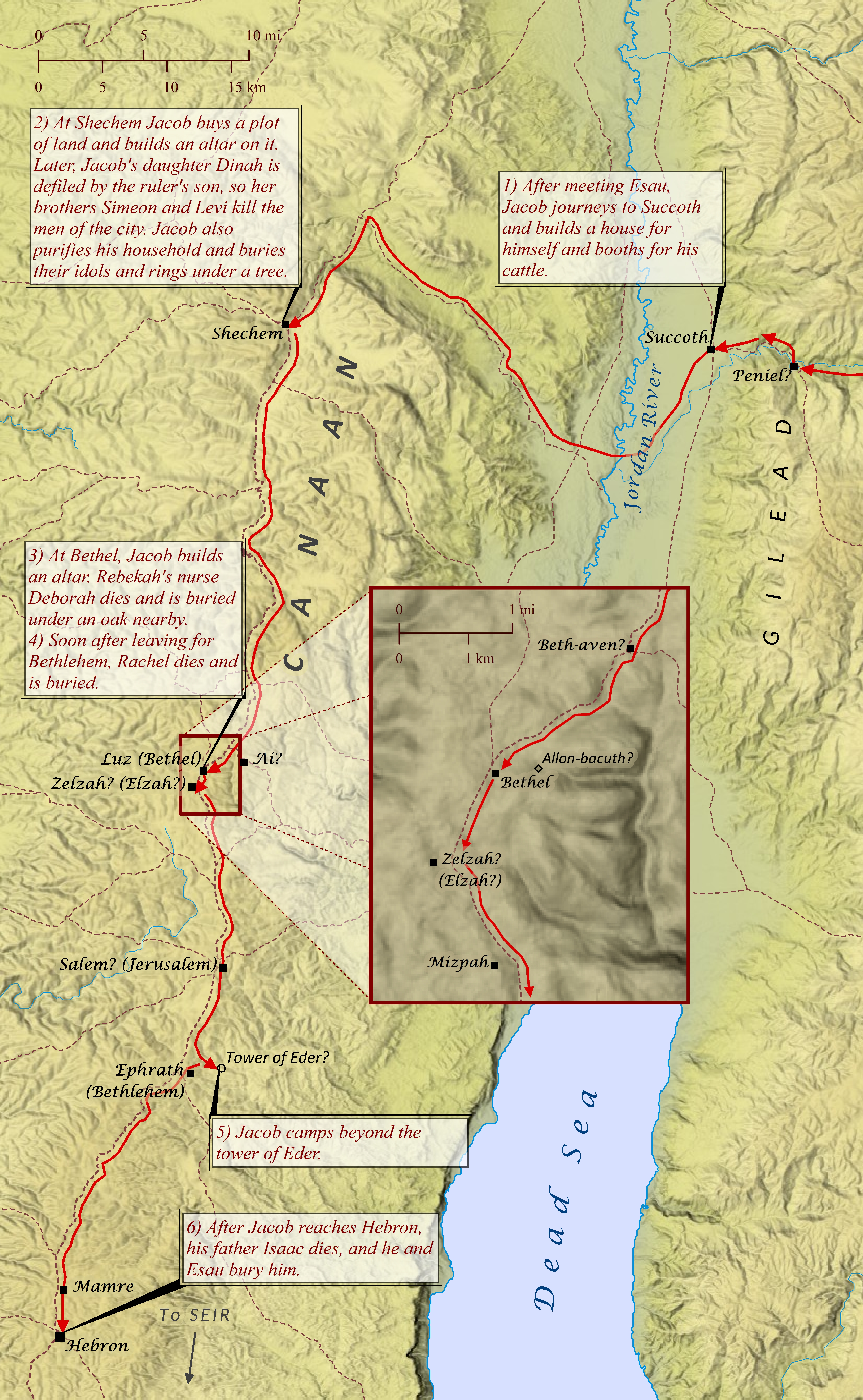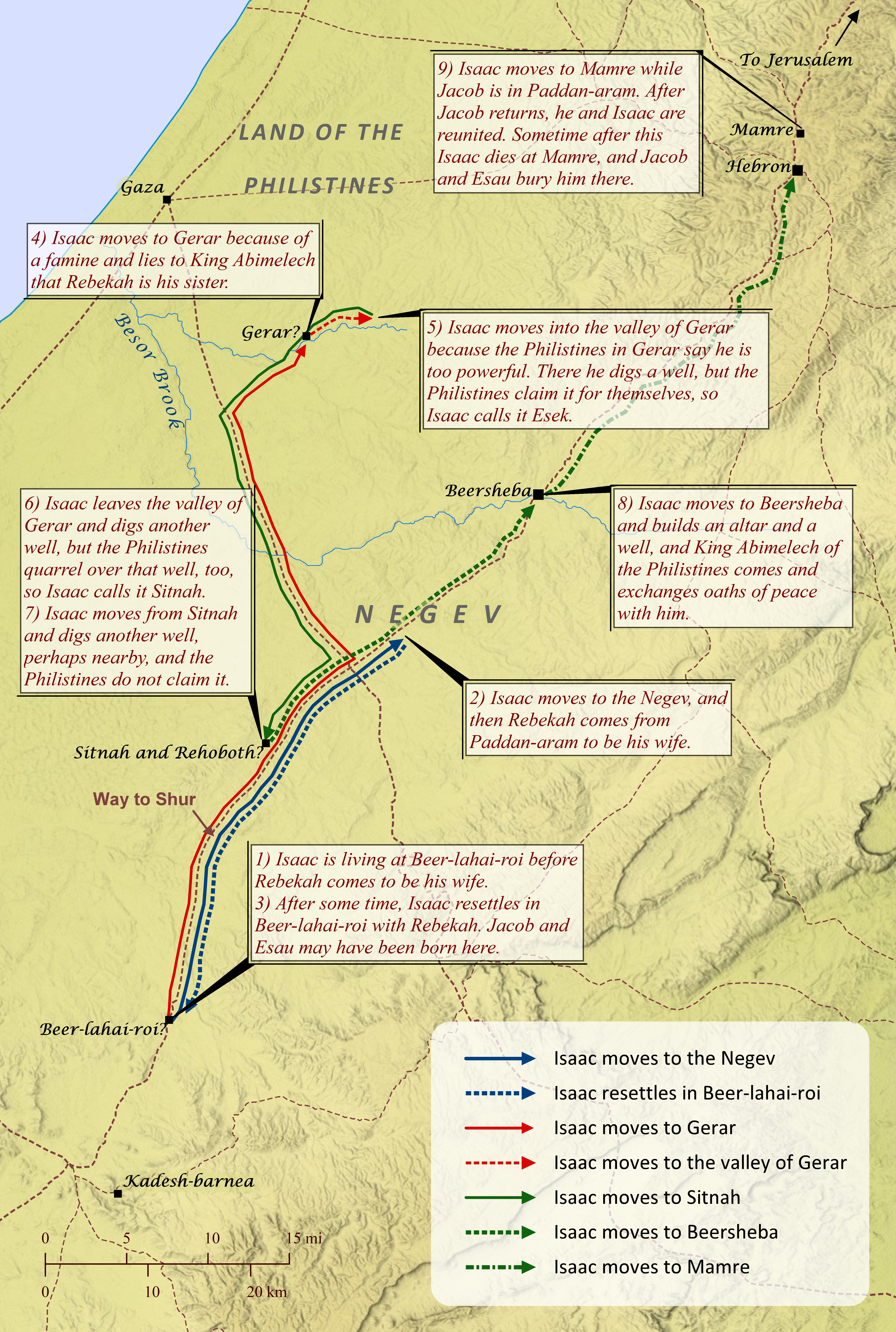
Jacob Travels to Southern Canaan
Genesis 32-36
As with many of the stories of the Bible, the events of Jacob’s life are often misunderstood by readers as disjointed pericopes arranged primarily for theological and cultural purposes. Because of this, readers often fail to see that these stories follow a clear geographical progression of the patriarch throughout the land of Canaan. This realistic and coherent geographical framework behind the stories gives strong support to the belief that these stories are authentic, historical accounts of the experiences of Jacob and his ancestors. The overall framework for virtually all of Jacob’s stories is very simple: Jacob is born and raised in southern Canaan but comes into conflict with his twin brother Esau, so he flees to Paddan-aram in Mesopotamia (Genesis 25-28; see “Jacob Goes to Paddan-Aram” map). There he builds a large family and great wealth (Genesis 29-30) and eventually returns to southern Canaan, likely retracing the exact steps he followed when he fled (Genesis 31-35; see also “Jacob Returns to Canaan” map). During this time, Esau moves to the hill country of Seir, likely just south of southern Canaan (“Edom and the Land of Seir” map), and establishes his own family there, giving rise to the nation of Edom (Genesis 36). Though the primary intent of Jacob’s return was no doubt to resettle in Canaan, comments made during his reunion with Esau near Peniel may reveal that he also intended to travel even further to Seir to visit his brother there (Genesis 33:12-14). After crossing from Mahanaim to Peniel in Gilead, Jacob reunites with Esau and settles in Succoth for a time and builds a house for himself and booths for his cattle. He eventually crosses the Jordan River and enters Canaan, stopping first at the ancient city of Shechem. There Jacob’s daughter Dinah is defiled by the son of the region’s leader, and her brothers take revenge by killing all the men of the city. Thus, Jacob is forced to leave, but first he calls upon all his household to purify themselves. He collects their idols and rings and buries them beneath a tree in Shechem. Upon reaching Bethel, Jacob builds an altar and calls it El-bethel. The nurse of Jacob’s mother Rebekah also dies at Bethel and is buried under an oak below the town, leading them to call the place Allon-bacuth (“oak of weeping”). Jacob and his family leave for Bethlehem, but very soon after they start the journey Rachel gives birth to Benjamin and then dies. Jacob buries her along the way, apparently near a place called Zelzah (or perhaps Elzah; see 1 Samuel 10 and “Saul Search for His Donkeys” map). Jacob continues on and camps beyond the tower of Eder, perhaps near Bethlehem, since that seems to have been his original destination. Finally Jacob reaches Mamre and Hebron. Soon after this Isaac dies, and Esau and Jacob bury him. The story of Jacob’s journey ends at Genesis 35, and we are not explicitly told if Jacob traveled even further to Seir. Genesis 36, however, catalogs the descendants of Esau, the Edomites, perhaps indicating that Jacob did indeed fulfill the intentions he stated in Genesis 33:12-14.

Isaac’s Travels
Genesis 21-35
Though the patriarch Isaac moved from place to place several times within southern Canaan, compared to his father Abraham and his son Jacob, Isaac appears to have been a bit of a homebody. In fact, unless Isaac resettled in places not recorded in Scripture, the farthest extent he ever traveled appears to have been only about 90 miles (113 km). Yet, as the child of God’s promise to Abraham to build a great nation from his descendants, Isaac’s relatively simple life served as a critical bridge from Abraham to the beginnings of the twelve tribes of Israel, who were descended from Isaac’s son Jacob. It is likely that Isaac was born at Beersheba (see Genesis 21:1-24), and later Abraham offered him as a sacrifice on Mount Moriah (located at Jerusalem; see 2 Chronicles 3:1). Then Abraham, Isaac, and those with them returned to Beersheba (Genesis 22:1-19). When Isaac reached adulthood, his father sent a servant to bring back a bride for him from Aram-naharaim, far north of Canaan. When his bride, Rebekah, arrived, Isaac had just come from Beer-lahai-roi and settled in the Negev (Genesis 24:62). Later Isaac resettled with Rebekah in Beer-lahai-roi, and this may have been where their twins son Esau and Jacob were born. A famine forced Isaac to go to Gerar (Genesis 26:1-6) in “the land of the Philistines.” The distinct people group known as the Philistines in later books of the Bible did not arrive until the time of the Judges, so the term here must have referred to another people group living in this region, and this is supported by the fact that King Abimelech’s name is Semitic, not Aegean (the likely origin of the later Philistines). While Isaac was there, he repeated his father’s error (Genesis 20) by lying to the king that his wife was only his sister. Isaac also became increasingly prosperous at Gerar, so the Philistines told him to leave their region. Isaac moved away from the town of Gerar and settled further away in the valley of Gerar. There he dug a well, but the Philistines claimed it for themselves, so he called it Esek, meaning “argument.” So Isaac’s men dug another well and called it Sitnah (meaning “hostility”), but it led to more quarreling, so he dug yet another well and called it Rehoboth (meaning “open space”). The locations of these two later wells are not certain, but they may have been located near Ruheibeh as shown on this map. Then Isaac moved to Beersheba and built an altar. He also dug a well there, and King Abimelech of the Philistines came and exchanged oaths of peace with him. It was likely at Beersheba that Isaac blessed his sons Esau and Jacob, and both sons eventually left Canaan (see “Jacob Goes to Paddan-Aram” map). When Jacob later returned, he traveled to Mamre near Hebron and reunited with Isaac. Sometime after this Isaac died, and Jacob and Esau buried him there.